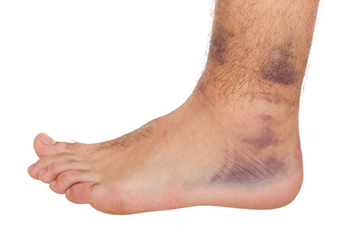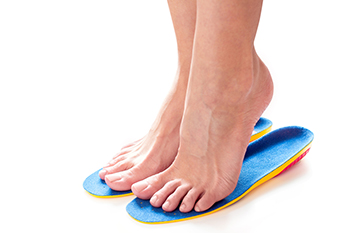(517) 487-5171
Fax (517) 908-0172
April 2022
Spraining an Ankle

An ankle sprain occurs when the foot inverts and twists causing the ankle joint out of its normal position. The ankle injury is sustained on the lateral ankle complex, composed of three ligaments – talofibular, calcaneofibular, and posterior talofibular – that hold the ankle bones and joints together. There may be small tears and damage to tendons, cartilage and blood vessels and there will usually be pain when weight is placed on the affected ankle, swelling, and even bruising. Anyone can sprain an ankle but those who participate in sports, walk on uneven surfaces, or wear inappropriate footwear are more at risk. It can take several weeks, even months for a sprained ankle to heal completely. Calling a podiatrist is suggested if you feel you might have sprained your ankle to determine how severe the injury is, make sure it is not broken through various manipulations and one or more imaging studies, and to provide the proper course of treatment.
Ankle sprains are common but need immediate attention. If you need your feet checked, contact Dr. Gary Cesar from Michigan Foot and Ankle Center. Our doctor can provide the care you need to keep you pain-free and on your feet.
How Does an Ankle Sprain Occur?
Ankle sprains take place when the ligaments in your ankle are torn or stretched beyond their limits. There are multiple ways that the ankle can become injured, including twisting or rolling over onto your ankle, putting undue stress on it, or causing trauma to the ankle itself.
What Are the Symptoms?
- Mild to moderate bruising
- Limited mobility
- Swelling
- Discoloration of the skin (depending on severity)
Preventing a Sprain
- Wearing appropriate shoes for the occasion
- Stretching before exercises and sports
- Knowing your limits
Treatment of a Sprain
Treatment of a sprain depends on the severity. Many times, people are told to rest and remain off their feet completely, while others are given an air cast. If the sprain is very severe, surgery may be required.
If you have suffered an ankle sprain previously, you may want to consider additional support such as a brace and regular exercises to strengthen the ankle.
If you have any questions please feel free to contact our offices located in Lansing and Mt. Pleasant, MI . We offer the newest diagnostic and treatment technologies for all your foot and ankle needs.
What Are the Risk Factors for Developing Gout

Gout is an arthritic condition that can cause severe pain, redness, heat and swelling in the big toe joint (typically), as well as other joints. This condition is caused by an excessive amount of uric acid in the bloodstream. Uric acid is a byproduct that is produced when the body processes purines, which are chemical compounds found naturally in the body as well as in certain foods. It is believed that consuming large amounts of alcohol, red and organ meat, certain seafood, and high fructose drinks can increase a person’s risk for developing gout. Other risk factors include heredity, being male and/or obese, and having health conditions such as high blood pressure, diabetes, kidney problems, congestive heart failure, and more. Gout flares are sudden onsets of symptoms which can last for days or even weeks, only to disappear for long periods of time as the disease goes into remission for a time. While there is no cure for gout, a podiatrist can help create a treatment and management plan to manage pain and avoid the condition from worsening.
Gout is a foot condition that requires certain treatment and care. If you are seeking treatment, contact Dr. Gary Cesar from Michigan Foot and Ankle Center. Our doctor will treat your foot and ankle needs.
What Is Gout?
Gout is a type of arthritis caused by a buildup of uric acid in the bloodstream. It often develops in the foot, especially the big toe area, although it can manifest in other parts of the body as well. Gout can make walking and standing very painful and is especially common in diabetics and the obese.
People typically get gout because of a poor diet. Genetic predisposition is also a factor. The children of parents who have had gout frequently have a chance of developing it themselves.
Gout can easily be identified by redness and inflammation of the big toe and the surrounding areas of the foot. Other symptoms include extreme fatigue, joint pain, and running high fevers. Sometimes corticosteroid drugs can be prescribed to treat gout, but the best way to combat this disease is to get more exercise and eat a better diet.
If you have any questions please feel free to contact our offices located in Lansing and Mt. Pleasant, MI . We offer the newest diagnostic and treatment technologies for all your foot and ankle needs.
Why Do I Have Flat Feet and What Can I Do About It?
 Flat feet are also referred to as “fallen arches.” As the name suggests, this condition results from collapsed arches or when the feet lay flat against the floor while walking. Babies and toddlers do not have arches at first, but they develop them as they grow. Flat feet can develop if arches do not mature normally. This may happen because of shoes that do not provide adequate arch support, wearing high heels, or overpronation (rolling inward) of the feet. While flat feet should not interfere with the usability of a person’s feet, the pain might be felt in the feet or calves since the feet must work harder to compensate for the lack of arches. If you suspect you have flat feet it is suggested that you see a podiatrist for proper evaluation, customized creation of arch supports, and any other treatment that may be required.
Flat feet are also referred to as “fallen arches.” As the name suggests, this condition results from collapsed arches or when the feet lay flat against the floor while walking. Babies and toddlers do not have arches at first, but they develop them as they grow. Flat feet can develop if arches do not mature normally. This may happen because of shoes that do not provide adequate arch support, wearing high heels, or overpronation (rolling inward) of the feet. While flat feet should not interfere with the usability of a person’s feet, the pain might be felt in the feet or calves since the feet must work harder to compensate for the lack of arches. If you suspect you have flat feet it is suggested that you see a podiatrist for proper evaluation, customized creation of arch supports, and any other treatment that may be required.
Flatfoot is a condition many people suffer from. If you have flat feet, contact Dr. Gary Cesar from Michigan Foot and Ankle Center. Our doctor will treat your foot and ankle needs.
What Are Flat Feet?
Flatfoot is a condition in which the arch of the foot is depressed and the sole of the foot is almost completely in contact with the ground. About 20-30% of the population generally has flat feet because their arches never formed during growth.
Conditions & Problems:
Having flat feet makes it difficult to run or walk because of the stress placed on the ankles.
Alignment – The general alignment of your legs can be disrupted, because the ankles move inward which can cause major discomfort.
Knees – If you have complications with your knees, flat feet can be a contributor to arthritis in that area.
Symptoms
- Pain around the heel or arch area
- Trouble standing on the tip toe
- Swelling around the inside of the ankle
- Flat look to one or both feet
- Having your shoes feel uneven when worn
Treatment
If you are experiencing pain and stress on the foot you may weaken the posterior tibial tendon, which runs around the inside of the ankle.
If you have any questions please feel free to contact our offices located in Lansing and Mt. Pleasant, MI . We offer the newest diagnostic and treatment technologies for all your foot and ankle needs.
Are Bunions Affecting Your Everyday Life?
Flat Feet and Orthotics
Many people are born with flat feet. There may be additional causes for flat feet to develop that can include pregnancy, arthritis, diabetes, or even an injury. Orthotics are custom made inserts that are designed to fit inside shoes. Research has indicated that wearing orthotics may help patients with flat feet. The benefits of wearing orthotics can include shock absorption, improved balance, and support for the arch and heel. Additionally, orthotics may reduce existing pain that some patients experience because of flat feet. If you have this condition, and are interested in learning more about how orthotics can help you, please consult with a podiatrist.
If you are having discomfort in your feet and would like to try orthotics, contact Dr. Gary Cesar from Michigan Foot and Ankle Center. Our doctor can provide the care you need to keep you pain-free and on your feet.
What Are Orthotics?
Orthotics are inserts you can place into your shoes to help with a variety of foot problems such as flat feet or foot pain. Orthotics provide relief and comfort for minor foot and heel pain but can’t correct serious biomechanical problems in your feet.
Over-the-Counter Inserts
Orthotics come in a wide variety of over-the-counter inserts that are used to treat foot pain, heel pain, and minor problems. For example, arch supports can be inserted into your shoes to help correct overarched or flat feet, while gel insoles are often used because they provide comfort and relief from foot and heel pain by alleviating pressure.
Prescription Orthotics
If over-the-counter inserts don’t work for you or if you have a more severe foot concern, it is possible to have your podiatrist prescribe custom orthotics. These high-quality inserts are designed to treat problems such as abnormal motion, plantar fasciitis, and severe forms of heel pain. They can even be used to help patients suffering from diabetes by treating foot ulcers and painful calluses and are usually molded to your feet individually, which allows them to provide full support and comfort.
If you are experiencing minor to severe foot or heel pain, it’s recommended to speak with your podiatrist about the possibilities of using orthotics. A podiatrist can determine which type of orthotic is right for you and allow you to take the first steps towards being pain-free.
If you have any questions please contact our offices located in Lansing and Mt. Pleasant, MI . We offer the newest diagnostic and treatment technologies for all your foot and ankle needs.










